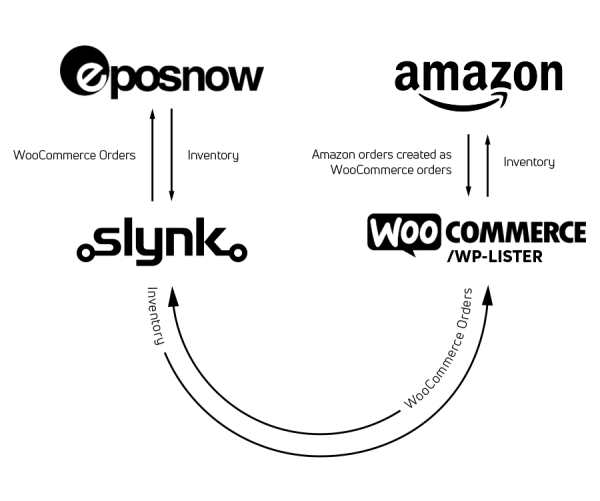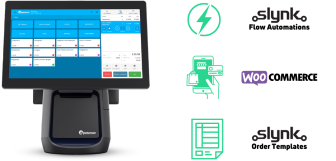Tips for better multi channel management for businesses
The retail landscape has undergone a big change in the post COVID world. Customers who were previously averse to shopping online had to get comfortable with it during the pandemic and new buying habits were created.
There are typically 3 types of customers:
- Those who have a strong preference of buying online
- Those who have a strong preference of browsing the shelves in-store and buying in-store
- A hybrid of the two above who want to browse online to identify the products they want and to be able to order them for click and collect
To maximise your sales potential, it is hugely beneficial to get your products in front of your customers in the places that they frequent and this is where a multi channel approach comes into its own.
Multiple sales channels
So first let's have a look at the main sales channels that are available.
Retail stores
This is where you have one or more bricks and mortar stores and is ideal for our first type of customer who wants to buy in-store only. It offers you the chance to provide a personal customer experience to build customer loyalty and encourage repeat business. People don't forget how you made them feel and seeing products in person is second to none.
If you are only selling online, then you are losing out on the customers who prefer to shop in store, and those who prefer click and collect. Not only that, having a physical store gives you credibility and gives the customer comfort that it is not a faceless business which might be gone at any moment. That cannot be underestimated.
eCommerce website
The most popular platforms for an online store are WooCommerce and Shopify but there are many others out there too. You can get up and running quickly with both of these and create professional websites with a smooth customer experience.
Having your inventory online allows customers to be able to view your product listings from anywhere and to be able to place orders easily and have them delivered without any of the hassle.
EposNow has integrations on their app store for the most popular eCommerce platforms which allows smooth inventory management across multiple channels. You can make sales online or in-store and your inventory remains in sync preventing over and under selling.
Online marketplaces & social media channels
If you are not listing your products on online marketplaces and on social media, then you are missing out on some huge marketing channels and leaving a lot of potential customers on the table.
It helps to think of these as huge malls with incredible footfall 24 hours a day, 7 days a week.
Sure, you have to give them some of your hard earned margin as commission but I find it really matters how you think of and categorise this cost.
If you think of it as the cost of 'renting' a shop in their 'mall', then the cost really isn't much different to your rent/costs for your physical store premises. In fact, it would work out much cheaper than if you had to rent a space in a very popular mall with high footfall.
Another way to think of it is as a marketing cost, as the cost to acquire a new customer who would not normally have bought from you, but because you are on a trusted online marketplace, they automatically trust it, that's what you're paying for.
This also opens up the possibility of a multi channel marketing strategy where customers have multiple touchpoints which builds brand recognition on multiple platforms. It also allows them to make the purchase on the platform that they trust along with and the customer experience that they are used to.
There are many different channels for online marketplaces with the most popular being Amazon, eBay and Etsy among others.
For social media, TikTok, Facebook, Instagram and Pinterest are the leaders. Having your products listed on these platforms opens up key marketing platforms where ads can be fine tuned to get your target customers looking at your listings. Combine this with influencer marketing in your niche and your target audience can really start to take notice leading to conversions.
Tips for better multi channel management for businesses
In this section we'll have a look at how you can identify the sales and marketing channels that work for your business and how you can manage the channels efficiently.
Identify the channels you want to target
The key to successful multi-channel marketing and selling lies in understanding your target audience and where and how they like to spend their time and money. Here is what you need to take into consideration:
Know your customers:
- Demographics: Age, gender, location, income, etc.
- Online behavior: What websites and social media platforms do they frequent?
- Shopping habits: Do they prefer researching online and buying in-store, or vice versa?
- Use data: Use any customer data that you may have already to validate your research for the points above
Research different channels:
- Popular options: Explore established channels like social media giants (Facebook, Instagram), online marketplaces (Amazon, eBay), email marketing, search engine optimization (SEO), and pay-per-click (PPC) advertising.
- Emerging channels: Consider newer platforms like TikTok or Pinterest, depending on your audience and product type.
- Match specific channels to target audiences: Focus on platforms where your target audience spends their time. A specific channel might be just right for a segment of your target customers so tailor your messaging accordingly to maximise the potential of that sales channel.
- Consider conversion potential: Some channels might be better for brand awareness while others might be more effective for driving conversions
Analyse your competitors:
- Identify their online presence: See which channels they use and how they position themselves.
- Look for gaps in their strategy: Are there any channels your competitors might be neglecting that could be a good opportunity for you?
Multichannel management
There are many benefits to multichannel marketing and multichannel selling, but it does come with its challenges.
Inventory management
The last thing you want to do is to have to create/update product listings on each channel manually. This is usually the biggest concern retailers have that stops them from selling on multiple channels. With a well thought out approach and using integrations, you can manage all your listings and stock levels in one place and they sync to all connected channels.
For example, our clients who sell in-store using Epos Now and online using WooCommerce use our Epos Now WooCommerce integration to keep their products, stock, orders and customers in sync seamlessly. This allows them to run their business efficiently knowing that they are not going to be overselling and also preventing underselling so that whenever they receive new stock, it is available for sale online immediately.
This can then be combined with integrations for WooCommerce with Amazon and eBay which perform the same function as our integration, and in this way, they have all their products, stock and orders in sync on all the connected platforms.
The illustration below shows how it is all connected to keep Epos Now, WooCommerce and eBay in sync. The same approach works for eBay and any other channels that integrate with WooCommerce.

With a setup like the one shown above, any orders that come in on Amazon/eBay are automatically created as orders in WooCommerce. These orders sync to Epos Now and stock levels are updated automatically.
When you are fulfilling these orders, you can do this directly on WooCommerce and it will update the order status on Amazon/eBay as well as sync any shipment tracking information you enter into WooCommerce. You never have to login to Amazon/eBay to process the orders, you can do that all directly from WooCommerce.
Another benefit of this is that all your orders are synced to Epos Now, so all your customer data is in one place and you can then analyze data using the reporting provided in EposNow to identify your best sellers and much more.
Product prices
When using a multi channel strategy where you are also building brand recognition, we recommend selling at the same price on all platforms. This allows for a smooth customer journey across multiple touchpoints on multiple channels. When customers see different prices on different channels it can plant a seed of doubt and create a barrier to purchase.
By having the same price on all channels, the customer doesn't worry about which specific platform they are buying from, they can simply use the one they are on at the moment. If a customer thinks 'I'll do it later', there is a high chance of this sale not converting as 'later' never happens.
Improve profit margins
As we touched on earlier, selling on popular channels like Amazon and eBay will incur a cost, but they do increase the sales volume due to the footfall that you get.
In an ideal world, prospective customers would discover you on these channels and maybe place their first order with you through these channels, and then place any future orders directly through your website or in-store where you can make the best profit margins on the sale.
To encourage this, think about putting flyers and promotional material in the packaging for any orders that are placed through channels that are not your own website or store. You'll also want to consider building an email marketing list so you can market to these customers directly.
Some channels will not provide direct email addresses for the customer who placed the order, so having a promotion where the customer is incentivised for signing up to your email list (maybe earning loyalty points for their next order) enriches your customer data and grows your direct marketing channels.
Seamless customer service
By creating multiple touch points for your customers, you also need to put in place a multi channel support strategy. You can usually specify multiple support channels for each specific sales channel. Example of support channels are:
- Phone support
- Email support
- Whatsapp messages
- Facebook messenger
- Direct messages on your instagram account
Monitoring each of the channels mentioned above sounds overwhelming right? Well, it doesn't have to be. Thankfully, there are plenty of CRM and Helpdesk software packages that make multi-channel customer support simple and easy to manage while keeping your support costs minimal.
They automatically monitor all these support channels for you in one place and allow you to reply to all messages from one place regardless of which channel they came in on.
This is essential to ensure you don't miss any messages from potential customers and that you are communicating with customers on their preferred platform without making your life any harder.
Harness the power of Google Shopping
Imagine you need some comfy new running shoes. You head to Google and type in "running shoes for women." Wouldn't it be amazing if your perfect pair popped right up at the top of the search results, with a picture, price, and maybe even some rave reviews about how supportive they are? That's the power of using Google Shopping for your business!
Even though these shoes may be sold by many retailers, you will be listed as one of the stores customers can buy from. If you build up your Google Reviews, this adds extra weight and trust to your store and can generate traffic to your listing for that shoe.
Most eCommerce platforms like WooCommerce will have plugins that allow you to sync your products on WooCommerce to Google Shopping automatically. Whenever you add/change products, it automatically updates the listing on Google Shopping too, so you don't even have to think about it.
Leveraging Paid Advertising Across Your Multi Channel Strategy
Listing your products on multiple channels is a great start, but you can put on your rocket boosters with strategic paid advertising to your target audience.
There are several ways to do this and the key ones are:
- Social media advertising: Platforms like Facebook, Instagram, and TikTok offer robust advertising tools. You can create targeted ad campaigns based on demographics, interests, and online behavior. You can target customers who have visited your website in the last 30 days and even show them adverts of products they have browsed on your website. Leverage features like Shoppable Posts on Instagram or Facebook Shops for a seamless in-app purchase experience.
- Search Engine Marketing (SEM): Employ pay-per-click (PPC) advertising with platforms like Google Ads. Bid on relevant keywords people search for to ensure your product listing appears at the top of search results. This increases your visibility to potential customers actively looking for products like yours. You can identify longer search terms (these are called long-tail) that your customers may be searching for from your industry knowledge and customer data which may not have much competition and will therefore be much cheaper.
- Online marketplaces: Many marketplaces offer advertising options. Promote your products within the platform's search results or display them on relevant category pages. This allows you to reach a vast audience actively browsing for products on established e-commerce platforms.
Wrapping up
I've hopefully given you an introduction to the benefits of a multi channel approach to marketing and sales, how to get started and how to optimise to get the maximum bang for buck.
A well thought out multi channel marketing strategy can reap dividends and can compound over time as your reputation on the various channels builds up. It is highly recommended and we have seen first hand how some of our clients have gone from strength to strength.
Remember, you don't have to be a tech expert to do this, and you don't have to do it alone. All you have to do is understand your customers and your products. There is software out there to make all of this very manageable and consulting with the right people can help you get up and running very quickly.
The best advice I can give is to take it one step at a time and build on it consistently over a period of time and you'll reap the rewards when it is done right. Good luck!




